Fred Van Lente stops by for International Children’s Day!
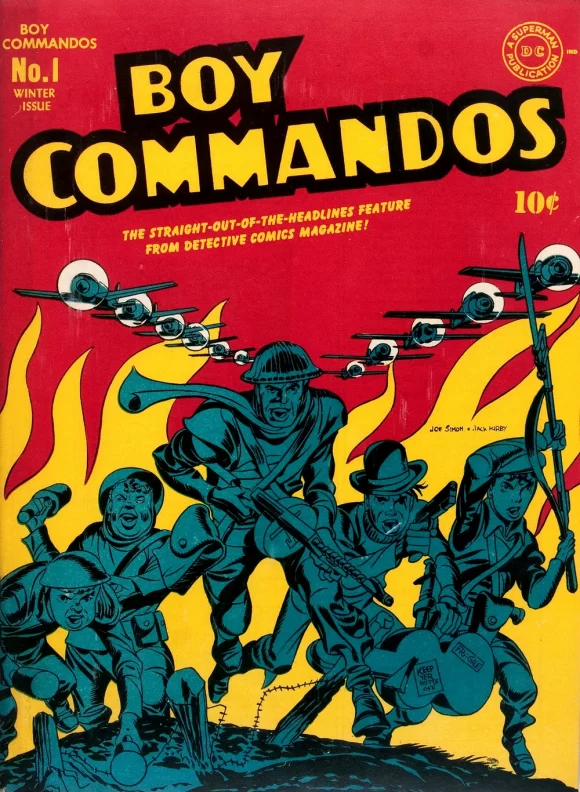
Possibly the most famous Kid Gang cover
By FRED VAN LENTE
“Kid Gangs,” vaguely defined as “a bunch of scrappy kids go on adventures” were a fairly popular movie genre in the first half of the 20th century, typified by the “Our Gang” series of shorts and “Dead End Kids” features. A reflection of a more urban America, kid gangs fell out of favor along with postwar suburbanization, though we Gen-Xers had The Goonies and The Cosby Kids, and the D&D-loving Hawkins kids of Stranger Things are absolutely the most popular modern-day iteration of the trope.
Early comics plundered any and all genres they could get their hands on. While Dell held the Little Rascals license along with many others, the absolute kings of original Kid Gangs were Golden Age powerhouses Joe Simon and Jack Kirby. Kid Gangs are probably the duo’s third-most popular creation, behind Steve Rogers and romance comics, and throughout his long, medium-defining career, Kirby would continue in the genre after he and Simon split in the mid-Fifties.
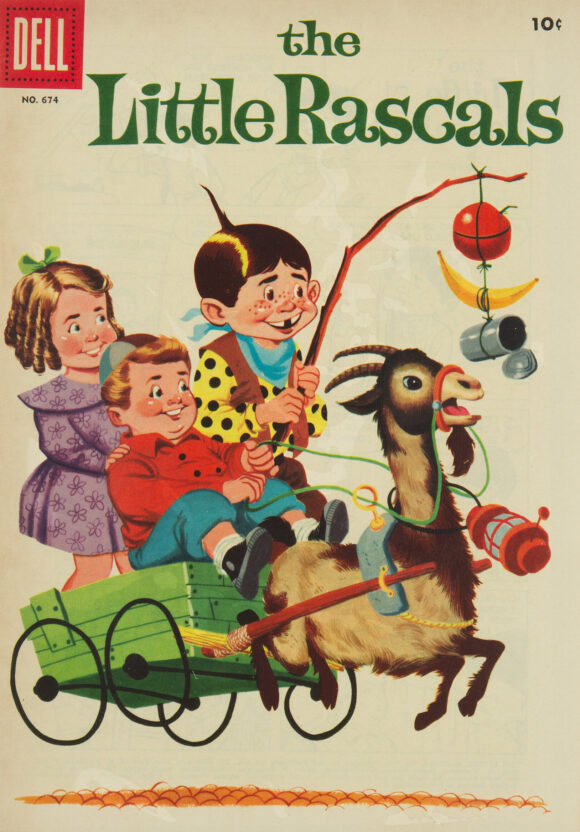
Dell’s Four Color #674, Jan. 1956. David Gantz cover.
I’m not just 13th Dimension’s resident Kirby addict; I also create comics for New York City’s Department of Education. The DOE recently asked Ryan Dunlavey and I to do a biographical Kirby comic for middle schoolers (which should debut in 2025), and while researching the King’s Lower East Side childhood, I had occasion to revisit all of his many Kid Gangs, and decided to rank them for your amusement and mine. Enjoy!
—
13. BOY EXPLORERS
First Appearance: Stuntman #1 (April 1946, Harvey)
Members: Gadget (Smart Kid), Gashouse (Tough Kid), Smiley (Leader Kid), Zero (Kid Kid) + Commodore Sinbad (sic, Token Adult)
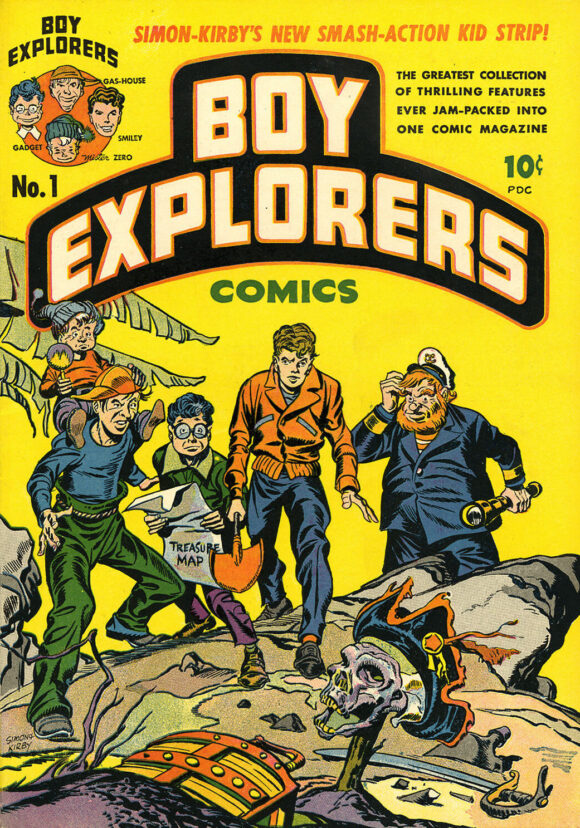
Following World War II, the superhero genre fell out of favor for the longest period since its inception, leaving Simon and Kirby creatively and commercially adrift. In this largely forgotten period between V-J Day and creating Young Romance, S&K packaged comics in many genres for various smaller publishers.
Joe Simon was tight with Al Harvey (in fact, Al’s secretary would soon become Mrs. Simon) and the duo knocked out various titles for his tiny company. The “Boy Explorers” were introduced as a text piece in Stuntman, the kind of lame cowled superhero S&K specialized in after leaving Captain America: Stuntman, Fighting American, Sandman, Guardian, Manhunter, et al, all look like Cap-without-wings to me.
Likewise, the Boy Explorers seem like a pale imitation of the more famous Kid Gangs on this list; their solo Harvey title lasted a single issue on the newsstands, done-in by a flood of new comics after wartime paper rationing was lifted.
—
12. THE SENTINELS OF LIBERTY
First Appearance: Captain America Comics #1 (March 1941, Timely)
Members: You, the Readers + Bucky Barnes (honorary Leader Kid)

The first issue of Simon and Kirby’s Captain America Comics sold half a million copies, Timely/Marvel’s biggest hit to date; sales would double as the series continued. Timely publisher Martin Goodman exploited Cap’s popularity with an in-house fan-club, the Sentinels of Liberty. You sent a a dime in to Timely and you got back a membership card and bronze pin. Timely house ads claimed members of this “gang” numbered over 10,000 before wartime metal rationing forced the discontinuation of the badges.
Of course, the notoriously cheap Goodman didn’t share any of those dimes with Simon or Kirby. They’d jump ship for a higher page rate at DC within a year.
—
11. DINGBATS OF DANGER STREET
First Appearance: 1st Issue Special #6 (Sept. 1975, DC)
Members: Good Looks (Leader Kid), Krunch (Tough Kid), Non-Fat (Kid Kid), Bananas (Comic Relief Kid) + Lt. Terry Mullins (Token Adult)

This comic is silly and cute, but reads like Kirby is fronting a cover band for himself. The Dingbats aren’t even the craziest Kirby issue of 1st Issue Special (that’d be Manhunter).
—
10. TEEN BRIGADE
First Appearance: The Incredible Hulk #6 (March 1963, Marvel)
Members: Rick Jones (Leader Kid), Various Annoying Friends of Rick Jones + The Hulk (Token Monster Adult)
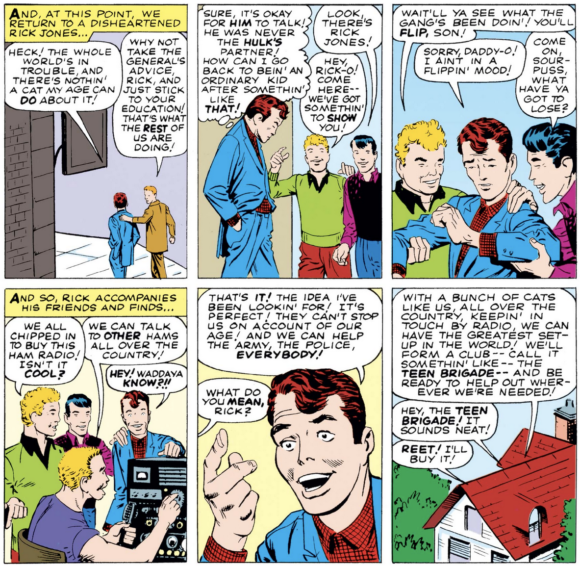
Rick Jones is the Marvel Universe’s crown prince of Failing Upward. He specializes in creating superheroes and superhero teams through brainless mishaps. He drives his hot rod onto a bomb site, obliging Bruce Banner to come save him and get bombarded by gamma rays. Then he organizes fellow like-minded teenage CB radio enthusiasts into the eponymous Brigade, alerting the Hulk about various threats to the Sun Belt. They create the Avengers by accident when a frantic message to the Hulk gets rerouted to Iron Man, Thor, and Hank Pym. Later, a solo Rick would free Captain Mar-Vell from the Negative Zone through similar buffoonery.
Now I want to do a mini-series in which we learn that Rick Jones accidentally dropped his spider collection in a Midtown High science exhibition, that he rammed Reed Richards’ rocket with his hot rod, knocking off its cosmic ray shielding, etc., etc. Basically showing he created the whole Marvel Universe through slapstick incompetence.
(Though Steve Ditko drew the Teen Brigade’s first appearance, Kirby had already co-created its major players, so I’m counting it.)
—
9. THE YOUNG ALLIES
First Appearance: Captain America Comics #4 (June 1941, Timely)
Members: Bucky Barnes (Leader Kid), Toro (Flaming Kid), Knuckles (Tough Kid), Jeff (Rich Kid), Tubby (Comic Relief Kid), Whitewash Jones (Racist Stereotype Kid)

Simon and Kirby were in the process of jumping ship to DC during this period, so they only did the first two covers and splash pages for this team, which originally appeared in a Stan Lee-penned text feature (as an in-continuity “Sentinels of Liberty”).
As you can see from the cover of Young Allies Comics #1, they fought the Red Skull and Hitler on their inaugural mission, so these teen titans started at the top. This is the first time characters from other Timely books teamed up in a separate title—DC’s Justice Society of America had just premiered six months before.
—
8. THE SUFFOLK STREET GANG
First Appearance (in comics): “Street Code,” Argosy Vol. 3, No. 2 (Nov. 1990, Richard Kyle Publications)
Members: Jacob Kurtzberg (Tough Kid) + Others
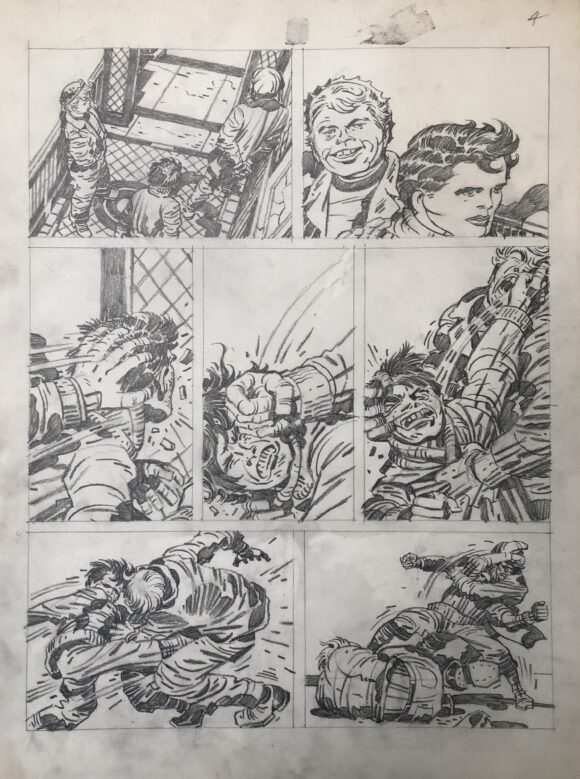
Original pencils
The “Dead End Kids” and “Bowery Boys” were all good Hollywood fun, but Jacob “Jakie” Kurtzberg lived the harsh reality, explicated in this disturbing autobiographical tale pencilled for a struggling start-up fiction magazine. All trace of cosmic sentimentality—or any kind of sentiment—are stripped away on the Darwinian streets of the Lower East Side. Big kids in Jakie’s own building beat him up just because he’s smaller than them; their brutal fight is interrupted by word a gang from a rival block has shown up.
Why are these kids fighting? Over ethnic differences? Religious ones? It’s never made clear. Jakie himself doesn’t seem to know. Jakie would become “Jack Kirby” in his early 20s, circa 1940, picking a tough Irish pen name reminiscent of James Cagney, who grew up in a rough Manhattan neighborhood a few blocks over.
If you are at all interested in this stuff, try and tour the Lower East Side Tenement Museum on your next trip to New York City. It really is “Street Code” come to life.
—
7. NEWSBOY LEGION I
First Appearance: Star-Spangled Comics #7 (April 1942, DC)
Members: Tommy (Leader Kid), Big Words (Smart Kid), Gabby (Comic Relief Kid), Scrapper (Tough Kid) + Jim Harper/Guardian (Token Adult)

The first purely original strip Simon and Kirby created after defecting from Timely to DC, Legion defined the Kirby Kid Gang formula: scrappy juvenile delinquents that act as the Baker Street Irregulars for a boring adult hero, though they, the sidekicks, are the real stars of the show.
Their neighborhood, Suicide Slum, was clearly inspired by Jack Kirby’s Lower East Side (Joe Simon grew up in Rochester, NY). Located in “York City” in the Legion’s first appearance, Suicide Slum eventually got retconned to Metropolis (by Kirby, I believe, in New Gods #3), where it’s remained ever since.
—
6. THE FOREVER PEOPLE
First Appearance: The Forever People #1 (1971, DC)
Beautiful Dreamer (Girl Kid), Big Bear (Tough Kid), Mark Moonrider (Leader Kid), Vykin the Black (Smart Kid), Serifan (Kid Kid) + Infinity Man (Token Composite Adult)

As I said when I surveyed Kirby’s Fourth World titles, the Forever People don’t quite work, as their basic “Space Hippie” hook gets muddled by the fact we see them emerging from the Boom Tube here on Earth. Without any context for the hyper-violent conflict between New Genesis and Apokolips that they’re fleeing from/protesting against—to the point where they rip off a Super-Cycle and tell Highfather to go screw—they just come across as clueless, homeless roamers, i.e. actual, annoying hippies.
That said, though the Forever People themselves don’t gel, The Forever People series has some of the best moments in the entire Fourth World canon. Splitting that difference lands them in the middle of this list.
—
5. THE YANCY STREET GANG
First Appearance: Fantastic Four #6 (Sept. 1962, Marvel)
Members: Unknown

The Thing-tormenting street pranksters known as the Yancy (see: Delancey) Street Gang are unique in the Kirby Kid Gang oeuvre in that we don’t know any members by name, or even what they look like. It’s never really explained in the Lee/Kirby run why they delight in prank-stalking the FF so much. We get a slight hint that they might resent the fact that Ben Grimm is also from the same background as them (and Jack Kirby) and have taken it upon themselves to take him down a peg. They’re the “human resistance” proving to the supers that just because regular people don’t have super powers, they’re not powerless. A kid gang with an ideology! That’s why they rank so high on this list.
—
4. NEWSBOY LEGION II
First Appearance: Superman’s Pal Jimmy Olsen #133 (Oct. 1970, DC)
Members: Jimmy Olsen (Leader Kid), Tommy II (Another Leader Kid), Big Words II (Smart Kid), Gabby II (Comic Relief Kid), Scrapper II (Tough Kid), Flippa Dippa (SCUBA Kid) + Superman (Token Kryptonian)
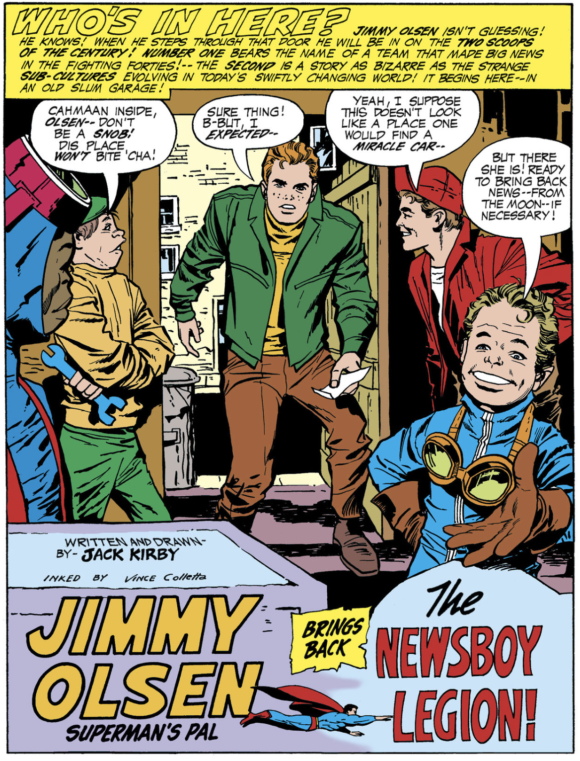
A rare instance of Kirby not just using legacy heroes—these Legionnaires are the sons of the originals—but reaching back into previous generations of his work for contemporary inspiration. Later, post-Crisis, they’d be declared clones of the originals, which isn’t as much fun. (I liked it when the adult Legionnaires showed up in Jimmy Olsen.) They are central to the gonzo Project Cadmus story arc, and I even enjoyed them going after the Loch Ness Monster with Jimmy later in Kirby’s utterly crackers run. Who couldn’t fall in love with an army of parachuting mini-Scrappers? Communists, that’s who.
—
3. BOY COMMANDOS
First Appearance: Detective Comics #64 (June 1942, DC)
Members: André (French Kid), Alfie (British Kid), Jan (Dutch Kid), Brooklyn (Tough Kid) + Captain Rip Carter (Token Adult)
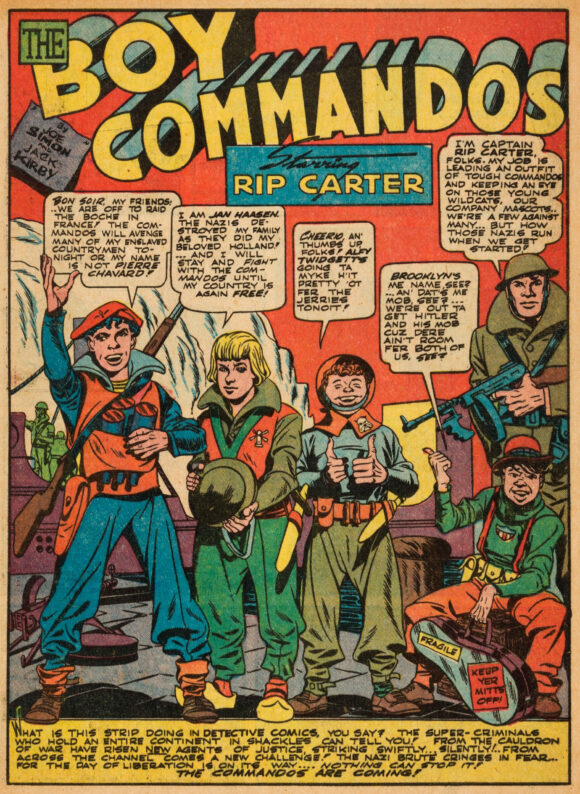
I personally find this early S&K effort borderline unreadable, but its overwhelming popularity demands high inclusion on this list. Boy Commandos would be DC’s biggest wartime best-seller behind only Batman and Superman. Kids really wanted to shoot Nazis back in those days, and lived vicariously through this hard-fighting band of war orphans.
Furthermore, the title is extremely significant in Jack Kirby’s development as an artist—his bombastic style begins to shake the crudeness of the Captain America and Newsboy Legion strips. In Commandos, S&K also perfect the art of the Double-Page Splash, a massive explosion of action that was their calling card.
—
2. BOYS’ RANCH
First Appearance: Boys’ Ranch #1 (Oct. 1950, Harvey)
Members: Dandy (Leader Kid), Wabash (Comic Relief Kid), Angel (Tough Kid), Happy Boy (Kid Kid) + Clay Duncan (Token Adult)

This Harvey Comics title about orphans who inherit a ranch in the town of “Four Massacres” lasted only six issues, but is lauded by many (myself included) as the single best Joe Simon/Jack Kirby collaboration. It’s definitely Kirby’s best Western, of which he did many, particularly at Atlas/Marvel.
The most compelling character in any of the Kid Gangs is Angel, a kind of proto-Orion whose cherubic good-looks mask deep-seated anger. “Mother Delilah,” a heart-breaking tale from Boys’ Ranch #3, concerns a cruel woman who exploits Angel’s desperate desire for a mother figure to get back at his mentor Clay. “Delilah” is arguably the best single story the duo ever produced.
—
1. THE X-MEN
First Appearance: The X-Men #1 (Sept. 1963, Marvel)
Members: Cyclops (Leader Kid), Iceman (Kid Kid), Angel (Rich Kid), Beast (Tough THEN ALSO Smart Kid), Marvel Girl (Girl Kid) + Professor X (Token Adult)
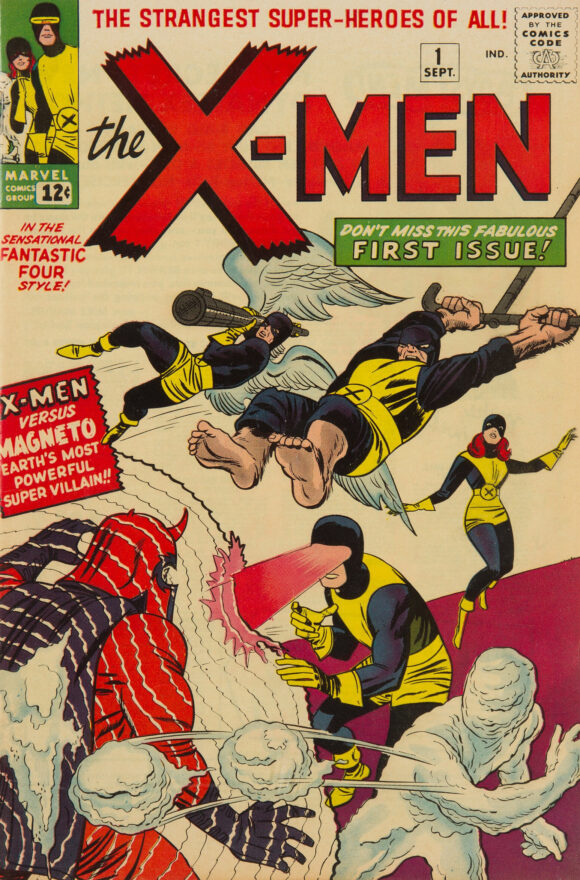
“What if Kid Gang, but Powers?” Though they wouldn’t really take off until Wein, Claremont, Cockrum and Byrne came along, from Jack Kirby’s pencil first flowed the Danger Room, a Super-School of Good versus a Brotherhood of Evil Mutants, and so on. The simultaneous perfection and evolution of a formula. ’Nuff said, etc.
—
MORE
— Take Flight With SIMON and KIRBY’s THE FLY — 65 Years Later. Click here.
— Get Your Hands on SIMON and KIRBY’s First BLUE BOLT — Remastered For Your Enjoyment. Click here.
—
13th Dimension contributor Fred Van Lente is an award-winning, New York Times-bestselling comics writer, as well as an occasional novelist, teacher, and playwright. Sign up for updates on his upcoming projects and check out the trailer for his comics-writing course at his web site, fredvanlente.com.

June 9, 2024
I have never heard of Boy Explorers. Not a good review. Boy Commandoes is my pick as best of the lot. Number 2 is classic.
June 9, 2024
Lovely, lovely article, Fred. It has Kirby Crackle all through it. Hey, wasn’t “Deliah” Jack’s own favorite story of all? Or at least one of his top faves?
June 9, 2024
I am sure it was in his list of all-timers, Jim. I find it hard to believe Kirby would name a story he wasn’t solely credited for as writer and artist as his *favorite*, favorite though?
June 9, 2024
I remember Rick Jones and his short wave radio gang that accidently started the Avengers. They appeared in Hulk and other comics.